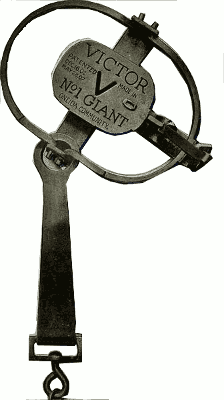Leg Hold Traps

Leg hold traps have been around for hundreds of years and there are many different designs and sizes of each design which tailors the trap for certain size prey. It is advisable to purchase these traps ahead of time, because they can be stored forever and are difficult but not impossible to make yourself. They will not last forever when being used as opposed to stored inside but they still last a long time and until you can progress to building your own via iron smithing. However, it is advisable to purchase a few before the SHTF.
The long spring leg hold trap shown in the picture will probably be the easiest leg hold trap to duplicate as it doesn't have traditional coil springs.
To use a leg hold trap is really pretty basic. The trap has a spring on one or two sides of the jaws. The jaws of the trap are forced closed by the springs. A pan or dish in the middle of the jaws releases a trigger that holds the jaws open when the trap is set. A chain or wire is used to secure the trap to the location it is set. This chain can be spiked to the ground via an end ring or wired to a small tree or bush or the trap is attached to something that will quickly tangle with local vegetation as it is pulled along the ground.
Sounds simple, and it is, but you aren't going to catch anything with your trap unless you use a little skill in setting the trap properly.
When setting the trap you will need to conceal it from the prey. Usually digging a small impression that is just big enough for the trap is dug. Very shallow mind you! Then grass and leaves are carefully laid over the trap to conceal its presence.
Entire books and magazines have been written about trapping and I certainly can't cover everything here. Just know that trapping skills are required to be successful and that blindly placing traps that are poorly concealed will almost never result in the catching of prey.
If you are unfamiliar with the behaviors of local animals because perhaps you live in the city then it is advisable to buy a book on trapping to store away with your traps.
A word of encouragement, when you read these trapping books they will be designed for perfection. Just as nobody writes a book on how to become only a decent football player, nobody writes a book on just getting by with trapping. Trapping books are invariably written for trappers to hone their skills to razor sharp perfection. Trust me when I say that boiling and waxing of traps etc. is not something that is required to be successful.
Maybe I will expound on this later by adding a series of articles on different types of sets, but for now, I will leave it right here.
